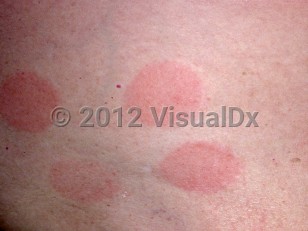Allergic contact dermatitis - Anogenital in
See also in: Overview,Cellulitis DDx,External and Internal Eye,Hair and Scalp,Nail and Distal Digit,Oral Mucosal LesionAlerts and Notices
Important News & Links
Synopsis

Allergic contact dermatitis (ACD) is a delayed-type (type IV) hypersensitivity reaction that occurs when allergens activate antigen-specific T cells in a sensitized individual. It typically requires repeated exposures before an allergic response is noted and most commonly occurs 24-48 hours after exposure to the offending agent.
ACD can occur in response to topical agents, systemic exposure via ingestion or implanted devices, or innocuous transfer of the culprit agent via the fingertips, such as a reaction to artificial nails.
Cases of vulvar ACD have been reported to topical medications such as nifuratel, an antibiotic, and topical anesthetics used to treat hemorrhoids, as well as contact with external materials such as sanitary pads, textiles, dyes in underwear and clothing, and hosiery. In some cases, sensitization to topical steroids is causative.
With regard to systemic exposure, clinically relevant reactions to spice and flavor allergens, such as Balsam of Peru, have been noted in a considerable number of cases of anogenital ACD. Additionally, nickel sensitivity has been noted in a subset of women with vulvar pruritus, and 50% of these patients had improvement in their symptoms with nickel avoidance. Baboon syndrome (symmetric, sharply demarcated erythema of the gluteal or inguinal area as well as other intertriginous or flexural sites) has also been reported as a presentation of systemic ACD. Medical devices, such as intrauterine devices for contraception, diaphragms, and condoms, have also been implicated. Exposure to inhaled substances, including pollen and latex, have been reported to cause vaginal ACD.
Related topic: irritant contact dermatitis
Codes
L23.9 – Allergic contact dermatitis, unspecified cause
SNOMEDCT:
40275004 – Contact dermatitis
Look For
Subscription Required
Diagnostic Pearls
Subscription Required
Differential Diagnosis & Pitfalls

Subscription Required
Best Tests
Subscription Required
Management Pearls
Subscription Required
Therapy
Subscription Required
Drug Reaction Data
Subscription Required
References
Subscription Required
Last Updated:10/03/2024
 Patient Information for Allergic contact dermatitis - Anogenital in
Patient Information for Allergic contact dermatitis - Anogenital in - Improve treatment compliance
- Reduce after-hours questions
- Increase patient engagement and satisfaction
- Written in clear, easy-to-understand language. No confusing jargon.
- Available in English and Spanish
- Print out or email directly to your patient



